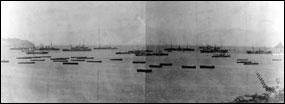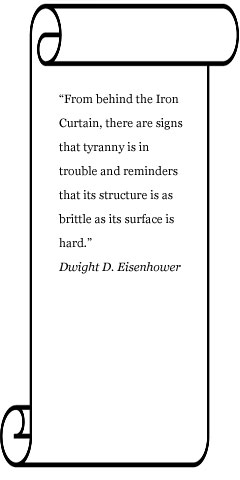| Political
Meddling in
Remember the Maine
February 2013
At the outbreak
of the Spanish-American War, the Spanish Navy
was woefully unprepared for what lay ahead
of them. With the exception of their torpedo
boats (which struck an almost irrational fear
into American hearts), Spanish warships were
either obsolete or in such bad repair that
they should never have left port. This is
the fleet the Spanish player commands in Great
War at Sea: Remember the Maine.
| 
One of those ships that should never
have left port: officers of armored
cruiser Cristobál Colón.
Note the empty mount for a never-fitted
10-inch gun.
|
But while the U.S. Navy was in far better
shape and went into action quickly and effectively,
the U.S. Army was tiny and nowhere near ready
to launch an overseas invasion. The National
Guard and eager volunteers swelled the ranks
of American ground forces quickly once war
was declared, but political wrangling, lack
of cooperation between the Army, National
Guard and Navy, and overall poor planning
kept U.S. ground forces landlocked until long
after the outbreak of war.
It didn’t have to be that way. Just
days after the commencement of hostilities,
Brigadier General William Shafter received
orders to assemble a force of six thousand
troops at Tampa, Florida. Their objective
was to sail to Cuba, march inland and link
up with Cuban rebels. This “Reconnaissance
in Force” would deliver American arms
and supplies to the independentistas and join
them in limited raids against Spanish positions.
It would then withdraw and sail back to the
U.S. with whatever intelligence it had gathered.
Later developments (among them reports by
gun runners that the Cuban rebels were much
weaker than previously thought) expanded Shafter’s
force mandate to 50,000 men, and changed his
mission to the invasion and fortification
of the port of Mariel as a beachhead for use
in marching on Havana.
| 
Spain’s best chance for naval
victory: Admiral Cervera’s fleet
in the Cape Verde Islands, April 1898.
|
Numerous factors conspired to prevent the
Reconnaissance in Force from ever sailing,
but it could have gone the other way. The
naval blockade of Cuba could not intercept
all Spanish supply shipments by itself, and
the Army chafed under a constant stream of
Navy demands for assistance on the island.
President McKinley was under heavy political
pressure to take strong early action, and
the Spanish were counting on the courts of
Europe to see prolonged U.S. Army inaction
as a sign of weakness. Several weeks without
an invasion of Cuba, or unanswered Spanish
victories at sea, could bring Germany and
other European powers into the war on the
Spanish side — a nightmare scenario
for the U.S. military and political establishments.
To simulate this uncertain situation, players
may agree at game start to use the Political
Meddling variant rules below. These rules
are appropriate for Remember the Maine operational
scenarios 1 through 4.
Variant Rule: Political Meddling
Every time Spanish forces sink a ship of any kind (warships,
transports, and/or merchant ships sunk as
a result of rolling on the Merchant Location
Table, 10.2), the Spanish player immediately
rolls two dice. Add +1 to the result for every
three ships the Spanish have sunk so far in
the scenario. Compare the modified result
to the table below and implement the results.
The same result may occur an unlimited number
of times unless the table says otherwise.
| Roll |
Effects |
| 2 – 9 |
None |
| 10 |
The U.S. orders its merchant ships into
port. The Spanish player immediately gains
4 VPs, and the density of all U.S. sea
routes is reduced by 1 (10.22). Once a
sea route’s density reaches zero,
the Spanish player may no longer search
for merchant shipping there. |
| 11 |
The U.S. Navy calls in a random warship
from the Caribbean for coastal defense
duties on the mainland. The U.S. player
counts up his active fleets and rolls
randomly to choose one, and then takes
all ship counters in that fleet and places
them in a container. The Spanish player
draws one out without looking. That ship
must break from its fleet (create an extra
fleet counter and box if necessary) and
sail directly for the coast of Florida
at maximum speed. It must then remain
in Florida coastal zones and/or Florida
Keys zones only for the rest of the scenario.
Any other ships which must leave for the
coast on later rolls of “11”
must link up with the coastal defense
fleet when they arrive at the Florida
coast. |
| 12 |
The McKinley Administration panics and
orders Shafter’s Reconnaissance
in Force to sail for Cuba immediately
with whatever escort is available. The
U.S. player creates a new fleet (create
an extra fleet counter and box if necessary),
places all currently-unused light warship
counters in a container, draws two out
without looking and places them in the
fleet box (each multiple-ship counter
drawn has only one ship in it). He then
rolls one die and adds eight to the result,
and places that many transports in the
fleet box as well. He then plots a transport
mission for that fleet to Cuban coastal
zone H6 or G8, entering the board at any
zone from A1 to A5 three turns from the
current turn. The Spanish player gets
5 VPs for every transport sunk, and the
US player gets 3 VPs for every transport
unloaded at zone H6 or G8. |
| 13+ |
Germany sides with Spain. The Spanish
player gains 20 VPs for the diplomatic
victory. This result can happen only once
— reroll if rolled subsequent times. |
Click
here to order Remember the Maine right now! |


